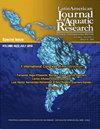墨西哥大西洋棕榈螺种群的遗传差异
IF 0.8
4区 农林科学
Q3 FISHERIES
Latin American Journal of Aquatic Research
Pub Date : 2022-05-01
DOI:10.3856/vol50-issue2-fulltext-2847
引用次数: 1
摘要
在过去的四十年里,棕榈Acropora的种群数量已经减少,尽管有一些关于加勒比地区它们遗传多样性的研究,但没有关于墨西哥湾南部珊瑚礁的研究发表。本研究旨在利用5个微卫星标记,确定位于墨西哥湾西南部、坎佩切海岸和加勒比海的墨西哥大西洋3个A. palmata种群的遗传变异。遗传丰富度(Ng/N)均值为0.583;最低的估计值对应于坎佩切河岸的珊瑚礁。遗传多样性较低(平均He = 0.315±0.052)。种群间显著的遗传结构可能与来自该地区的洋流和特定的生物学特性有关,主要是幼虫期短、死亡率高、自我招募率高。考虑到本区域缺乏这类研究,这些结果可能对设计管理战略特别有用。本文章由计算机程序翻译,如有差异,请以英文原文为准。
Genetic differences of Acropora palmata populations of the Mexican Atlantic
The populations of Acropora palmata have decreased over the last four decades, and although there are several studies on their genetic diversity in the Caribbean, no studies have been published about the reefs from the southern Gulf of Mexico. This research aimed to determine, using five microsatellite markers, the genetic variation of three A. palmata populations in the Mexican Atlantic located in the southwest Gulf of Mexico, in the Campeche Bank, and in the Caribbean. The mean of genetic richness (Ng/N) in the studied reefs was 0.583; the lowest estimated value corresponded to the Campeche Bank reef. A low genetic diversity was registered in the studied reefs (reef mean He = 0.315 ± 0.052). The significant genetic structure observed among studied populations could be related to ocean currents from the region and specific biological characteristics, mainly, short larvae phase, high mortality, and high rate of self-recruitment. These results may be particularly useful for designing management strategies, considering the lack of studies of this type in the region.
求助全文
通过发布文献求助,成功后即可免费获取论文全文。
去求助
来源期刊

Latin American Journal of Aquatic Research
FISHERIES-MARINE & FRESHWATER BIOLOGY
CiteScore
1.70
自引率
10.00%
发文量
44
审稿时长
4-8 weeks
期刊介绍:
Latin American Journal of Aquatic Research- LAJAR is the continuation of the journal Investigaciones Marinas (1970-2007) and is published since 2008 by the Escuela de Ciencias del Mar, Facultad de Ciencias del Mar y Geografía of the Pontificia Universidad Católica de Valparaíso. LAJAR is an “Open Access” journal that publishes in English language, original research articles, reviews and short communications on aquatic science, which contain the results of research conducted in aquaculture or in oceanic and coastal marine waters of Latin America.
The following topics are considered: Physical Oceanography, Chemical Oceanography, Marine Biogeochemistry, Marine Pollution and Toxicology, Marine Geology and Geophysics, Biological Oceanography, Fisheries and Aquaculture.
 求助内容:
求助内容: 应助结果提醒方式:
应助结果提醒方式:


